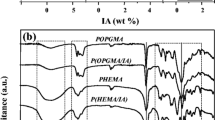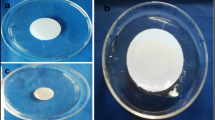Abstract
Stimuli-responsive hydrogels, based on 2-acrylamido-2-methyl-1-propansulfonic acid (AMPS) and poly N-vinyl 2-pyrrolidone (PVP) were synthesized via γ-ray irradiation technique to use as drug delivery system. The structure of PVP/AMPS hydrogels was confirmed using FT-IR, its morphology was studied using scanning electron microscopy (SEM) and the thermal properties were simultaneously studied by thermogravimetric analysis (TGA) and differential scanning calorimetry (DSC). Swelling behavior of the hydrogels was studied as a function of PVP:AMPS composition and irradiation dose in addition to temperature, pH and [NaCl] of the swelling medium. This work discusses the swelling kinetics of hydrogels and release dynamics of testosterone propionate (TP) as a model drug; from the hydrogel for the evaluation of swelling and drug release mechanisms. It has been observed from the release dynamics of drug that diffusion exponent ‘n’ have 0.61, 0.77 and 0.63 values and gel characteristics constant ‘k’ have 13.5 × 10−3, 7.0 × 10−3 and 19.5 × 10−3 values for the TP release, respectively, in distilled water, pH 2 buffer and pH 7 buffer. The ‘n’ values indicate that the swelling and release of drug from the hydrogels followed non-Fickian diffusion mechanism. In this mechanism, the rate of drug diffusion from the polymer matrix and rate of polymer chain relaxation are comparable. It has also been observed from the swelling and release of drug in the different pH buffer that the polymer matrix is pH responsive and can be exploited for the delivery of testosterone propionate drug to the colon.












Similar content being viewed by others
References
Abd El-Mohdy HL, Ghanem S (2009) J Polym Res 16:1
Lingyun C, Zhigang T, Yumin D (2004) Biomaterials 25:3725
Zhang XZ, Yang YY, Chung TS, Ma KX (2001) Langmuir 17:6094
Langer R, Peppas NA (2003) AICHE J 49:2990
Zhang R, Tang M, Bowyer A, Eisenthal R, Hubble J (2005) Biomaterials 26:4677
Abd El-Mohdy HL, Hegazy EA (2008) J Macromol Sci, Part A: Pure Appl Chem 45:1
Ostrovidova GU, Makeev AV, Shamtsian MM (2003) J Mater Sci Eng 23:545
Vinogradov SV, Bronch TK, Kabanov AV (2002) Adv Drug Deliv Rev 54:135
Bhattarai N, Ramay HR, Gunn J, Matsen FA, Zhang M (2005) J Control Release 103:609
Alarcon CDL, Penndam S, Alexander C (2005) Chem Soc Rev 34:276
Singh B, Vikrant S (2010) Int J Pharmacol 389:94
Nho YC, Park SE, Kim HI, Hwang TS (2005) Nucl Instrum Meth Phys Res 236(1–4):283
Ferrero C, Massuelle D, Doelker E (2010) J Control Release 141:223
Abd El-Mohdy HL, Abd El-Rehim HA (2008) Chem Eng J 145:154
Abd El-Mohdy HL, Abd El-Rehim HA (2009) J Polym Res 16:63
Abd El-Mohdy HL, Hegazy EA, El-Nesr EM, Abd El-Wahab M (2011) J Polym Res 18:1605
Tasdelen B, Kayaman-Apohan N, Guven O, Baysal BM (2005) Radiat Phys Chem 73(6):340
Soppimath KS, Kulkarni AR, Aminabhavi TM (2000) J Biomater Sci Polymer Ed 11(1):27
Soppimath KS, Aminabhavi TM (2002) Europ J Pharmacol Biopharm 53(1):87
David W, David JTH, Firas R, Andrew KW (2011) Radiat Phys Chem 80:207
Sen M, Yakar A (2001) Int J Pharmacol 228:33
Nart Z, Kayaman N (2011) J Polym Res 18:869
Guo XD, Zhang LJ, Chen Y, Qian Y (2010) AICHE J 56:1922
Singh B, Sharma DK, Kumar R, Gupta A (2009) Appl Clay Sci 45:76
Singh B, Sharma DK, Kumar R, Gupta A (2009) J Hazard Mater 161(1):208
Singh B, Sharma V, Kumar A, Kumar S (2009) Int J Biol Macromol 45:338
Bozkurt A, Ekinci O, Meyer WH (2003) J Appl Polym Sci 90:3347
Rosa F, Bordado J, Casquilho M (2003) J Appl Polym Sci 87:192
Travas-Sejdic J, Easteal A (2000) J Appl Polym Sci 75:619
Rivas BL, Pooley SA, Luna M, Geckeler KE (2001) J Appl Polym Sci 82:22
Zhao L, Xu L, Mitomo H, Yoshii F (2006) Carbohydr Polym 64:473
Abd El-Mohdy HL (2007) React Funct Polym 67:1094
Mano V, Silva M, Barbani N, Giusti P (2004) J Appl Polym Sci 92:743
Katarzyna K (2005) Eur Polymer J 41:55
Pourjavadi A, Barzegar S, Zeidabadi F (2007) React Funct Polym 67:644
Author information
Authors and Affiliations
Corresponding author
Rights and permissions
About this article
Cite this article
Abd El-Mohdy, H.L. Controlled release of testosterone propionate based on poly N-vinyl pyrrolidone/2-acrylamido-2-methyl-1-propanesulfonic acid hydrogels prepared by ionizing radiation. J Polym Res 19, 9931 (2012). https://doi.org/10.1007/s10965-012-9931-4
Received:
Accepted:
Published:
DOI: https://doi.org/10.1007/s10965-012-9931-4




